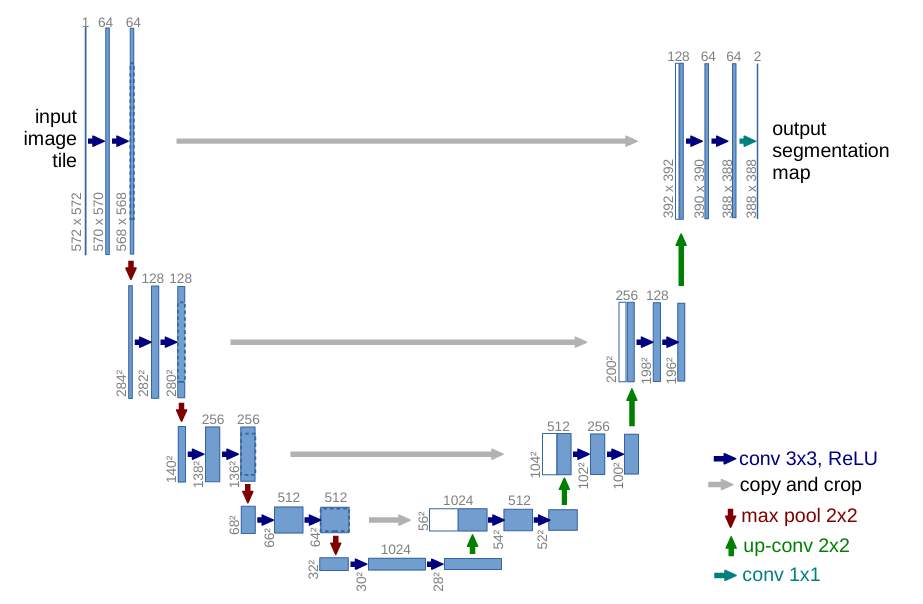python
复制代码
# unet_tutorial.py
import torch
import torch.nn as nn
import torch.nn.functional as F
# -------- 把打印函数写成一个工具 ----------
def print_shape(name, x):
print(f"{name:<12}: {tuple(x.shape)}")
# ----------- 基础卷积块:两次(Conv+BN+ReLU) -----------
class DoubleConv(nn.Module):
def __init__(self, in_c, out_c):
super().__init__()
self.conv = nn.Sequential(
nn.Conv2d(in_c, out_c, 3, padding=1, bias=False),
nn.BatchNorm2d(out_c),
nn.ReLU(inplace=True),
nn.Conv2d(out_c, out_c, 3, padding=1, bias=False),
nn.BatchNorm2d(out_c),
nn.ReLU(inplace=True)
)
def forward(self, x):
return self.conv(x)
# ----------- 下采样:MaxPool + DoubleConv -----------
class Down(nn.Module):
def __init__(self, in_c, out_c):
super().__init__()
self.pool_conv = nn.Sequential(
nn.MaxPool2d(2),
DoubleConv(in_c, out_c)
)
def forward(self, x):
return self.pool_conv(x)
# ----------- 上采样:转置卷积或插值 + 拼接 + DoubleConv -----------
class Up(nn.Module):
def __init__(self, in_c, out_c, bilinear=True):
super().__init__()
if bilinear:
self.up = nn.Upsample(scale_factor=2, mode='bilinear', align_corners=True)
self.conv = DoubleConv(in_c, out_c)
else:
self.up = nn.ConvTranspose2d(in_c, in_c//2, 2, stride=2)
self.conv = DoubleConv(in_c, out_c)
def forward(self, x1, x2):
x1 = self.up(x1)
# 处理尺寸不一致
diffY = x2.size(2) - x1.size(2)
diffX = x2.size(3) - x1.size(3)
x1 = F.pad(x1, [diffX//2, diffX-diffX//2,
diffY//2, diffY-diffY//2])
x = torch.cat([x2, x1], dim=1)
return self.conv(x)
# ----------- 输出1×1卷积 -----------
class OutConv(nn.Module):
def __init__(self, in_c, n_classes):
super().__init__()
self.conv = nn.Conv2d(in_c, n_classes, 1)
def forward(self, x):
return self.conv(x)
# ----------- 完整 UNet -----------
class UNet(nn.Module):
def __init__(self, n_channels=3, n_classes=1, bilinear=True):
super().__init__()
self.inc = DoubleConv(n_channels, 64)
self.down1 = Down(64, 128)
self.down2 = Down(128, 256)
self.down3 = Down(256, 512)
factor = 2 if bilinear else 1
self.down4 = Down(512, 1024 // factor)
self.up1 = Up(1024, 512 // factor, bilinear)
self.up2 = Up(512, 256 // factor, bilinear)
self.up3 = Up(256, 128 // factor, bilinear)
self.up4 = Up(128, 64, bilinear)
self.outc = OutConv(64, n_classes)
def forward(self, x):
print_shape("input", x)
x1 = self.inc(x) ; print_shape("x1", x1)
x2 = self.down1(x1) ; print_shape("x2", x2)
x3 = self.down2(x2) ; print_shape("x3", x3)
x4 = self.down3(x3) ; print_shape("x4", x4)
x5 = self.down4(x4) ; print_shape("x5", x5)
x = self.up1(x5, x4) ; print_shape("up1", x)
x = self.up2(x, x3) ; print_shape("up2", x)
x = self.up3(x, x2) ; print_shape("up3", x)
x = self.up4(x, x1) ; print_shape("up4", x)
logits = self.outc(x) ; print_shape("logits", logits)
return logits
if __name__ == "__main__":
model = UNet()
print(model)
input = torch.randn(2,3,256,256)
_ = model(input)
bash
复制代码
input : (2, 3, 256, 256)
x1 : (2, 64, 256, 256) # 卷积后尺寸不变
x2 : (2, 128, 128, 128) # MaxPool 2×
x3 : (2, 256, 64, 64)
x4 : (2, 512, 32, 32)
x5 : (2, 512, 16, 16) # 512=1024//2 (bilinear=True)
up1 : (2, 256, 32, 32) # 上采样2×,与x4拼接→512→256
up2 : (2, 128, 64, 64)
up3 : (2, 64, 128, 128)
up4 : (2, 64, 256, 256)
logits : (2, 1, 256, 256) # 输出与原图同尺寸
